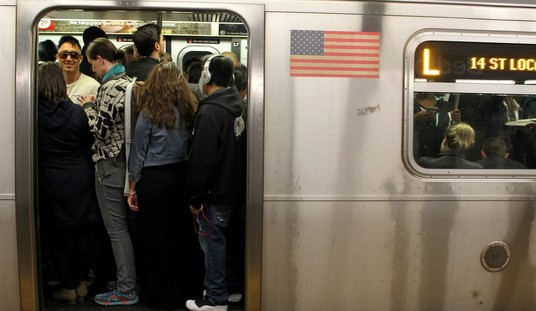It was a sunny Friday afternoon just five years ago. My wife was in New Orleans helping her sister move into her new Warehouse District condo. At lunch, they noticed that a storm had moved into the Gulf, and was threatening the central Gulf Coast. It was the “K” storm, already 2005’s eleventh named storm, too many for late August.
It would be a solid week before Lt. Gen. Russell Honore of the Louisiana National Guard United States Army would set foot in the city, to reclaim it and to reestablish some semblance of order.
By that time, Katrina had claimed over 1,000 lives. Katrina didn’t discriminate along racial lines, but the vast majority of her victims were old. If the situation had been different, Ernie might have been one of them.
Ernie was a true child of the city. He grew up in the neighborhood called Mid-City, in the Depression. His father was not much of a provider. His long-suffering mother, of strong German stock, had to work to make ends meet and to feed her four children.
Ernie grew up in the street, and quit school by eighth grade. For money, he ran orders for the Cotton Exchange. He also sold Cokes in an office building; he couldn’t use the elevator, so he would carry two buckets of Cokes on ice up several flights to make a few nickels.
While he may not have been book-smart, Ernie was street-smart. He learned to play cards with his family. He escaped his childhood at 17 by joining the military during World War II. Ernie served stints in the Army Air Force and in the Marines, where his card-playing skills earned him more money in the service than he had ever had in civilian life.
It was his love of cards that would ultimately pull him back to New Orleans after Katrina, but I’m getting ahead of myself.
My mother-in-law Rena met Ernie in 1992, when they were both widowed. Ernie had no children. They saw each other nearly every day, but never lived together until events dictated otherwise.
Rena was just as much a New Orleans character as was Ernie. She had been raised off Esplanade Avenue, near the Fair Grounds (which is not really a fairground, but a race track). Her entire married life was spent in suburban Jefferson Parish, just across the 17th Street Canal from the city.
Rena evacuated to our house early on the Saturday before Katrina’s landfall. It was her third evacuation of 2005, and she resolved that it would be her last.
By 2005, Ernie barely got around with the aid of a walker. His plan to ride out the storm in his modest brick double was simple: a loaf of bread, three pounds of Chisesi’s ham, and a six-pack of Cokes. In an emergency, he would go to the split level house next door. Ernie wasn’t particularly concerned about Katrina, because even in Hurricane Betsy (1965), water only got to the top of his curb on W. Brooks Street in Lakeview, only two blocks from the 17th Street Canal.
(That’s what many old time New Orleanians thought: Hurricane Betsy set the bar for how bad a hurricane could get. In reality, Betsy was a Cat 3 storm that gave the city a glancing blow.)
Sunday morning, we awoke and put on the TV. Overnight, Katrina had strengthened, as its course bore down on New Orleans. My wife phoned Ernie and ordered him to evacuate immediately. She was probably the one person he couldn’t ignore. He came to our house (125 miles to the west of New Orleans) with three days’ change of clothes. The drive took him only six hours because most of New Orleans had already evacuated.
(The evacuation of the city was remarkably efficient. Planners had learned their lesson from a failed dress rehearsal in 2004’s Ivan. For Katrina, the contraflow lanes on the interstate highways got everyone out of the city who wished to leave. Compare Houston’s disastrous attempt to evacuate the city for Rita, just a month after Katrina.)
As we watched the storm reports that night in Lafayette, it seemed at first that New Orleans had dodged a bullet. Only later came the grim news that the levee on the 17th Street Canal had failed – it had not been overtopped, as everyone always assumed. The levee’s foundation failed under the pressure of several feet of water. A section some 50 yards wide slid across the ground as if on ice, pushing into the adjoining residential area. Much of the city was to become, effectively, an arm of Lake Pontchartrain.
(An important geotechnical digression here, on a couple of points. New Orleans depends on a drainage system designed in the 1880s which was hailed as one of the engineering wonders of the 19th century. It’s a great drainage system, designed around the city’s frequent torrential rains, but it has one fatal flaw: the massive pumps are in the middle of the city, instead of at the canals’ outfall at Lake Pontchartrain. Consequently, Orleans Parish has to maintain many more miles of levee than Jefferson Parish, which has a more modern system. Levees are like chains, only as good as the weakest link. A lot of attention had been paid to building the levees up, so they wouldn’t be overtopped; not enough attention was paid to the levees’ foundations.)
(So the city’s drainage kept the older areas — the French Quarter, the Garden District and most of Uptown — relatively high and dry. From the 1920s to the 50s, there was a lot of development in an area closer to the Lake that was a natural swamp. In the prosaic imagination peculiar to real estate developers, it became known as “Lakeview”. Swamps are full of organic matter, which over the years dries out and compacts. The surface subsides. So every year, Lakeview got an inch or so lower below sea level.)
Within a few days of the storm, there were some 40,000 Katrina refugees in our town, including Rena, Ernie, my sister-in-law and her friend who stayed at our house. Sinking feeling #1 came when I accompanied Ernie to an Allstate tent at the Home Depot in Lafayette. My wife remembers that when we returned home, my face was white as a ghost. “Ernie has no flood insurance,” I told her. Didn’t need it. No mortgage. W. Brooks never flooded, not even in Betsy.
Three weeks later, my sister-in-law flashed her Corps of Engineers badge so we could get in to assess Ernie’s damage; except for rescue crews, hardly a soul had been into Lakeview. I’ll never forget standing on my tiptoes in the putrid muck in Ernie’s kitchen. I dipped a finger into a bowl on the top shelf of a cabinet. Water. At least eight feet of water. Sinking feeling #2.
Ernie had lost virtually every single material possession, except for some incidental jewelry, a rosary, and about $10 in quarters.
Rena was more fortunate. Her little double house was on Metairie Ridge, relatively high ground in Jefferson. She sustained a little wind damage to the roof, that’s all. But three evacuations in a year were enough for her. She was ready to move to Lafayette. And Ernie had no choice, and it made sense for them to live together.
To my wife’s everlasting credit, the night she saw the levees breached, she knew we had to find Rena and Ernie a place to live (besides our guest bedroom). By 10:00 a.m. the next morning, she had leased them a nice one-bedroom flat on the first floor of a new apartment complex. By 10:30, every single available apartment in town had been snapped up by the oil companies and large law firms from New Orleans, as refuge for their evacuated employees.
Ernie had a pension from a career at Western Electric, along with some savings. He was determined to rebuild, even against my advice. He had built his little home on W. Brooks in 1956. I remember that he could tell me to the penny how much it cost him to build ($13,427.83) and how much the small apartment addition cost in 1982 ($42,118.79). The house was his main financial asset.
Rena loved Lafayette, but she loved living with Ernie more. I think Ernie loved living with Rena but New Orleans was the center of his universe. Like many natives, he thought the sun rises in Chalmette and sets in Kenner (eastern and western suburbs, respectively). He especially loved Harrah’s casino in New Orleans, where he was an established regular in the card room. There are a couple of Indian casinos within driving distance from Lafayette, but they weren’t Harrahs! Ernie longed to be back in New Orleans, so he set plans to rebuild.
Early on, I had high hopes for New Orleans. The public school system was already a notorious failure and the state had taken over the worst performing schools. The devastation of the blighted public housing projects gave hope that they might be reborn in some more humane form.
Ernie went to New Orleans to secure his building permit. By rights, it should have cost him 1% of his estimated construction cost, or about $1,000. But his neighbor “knew a guy in City Hall” who owed him a favor. The permit cost $100. Sinking feeling #3: things were back to normal in City Hall. Official New Orleans hadn’t learned any lessons.
For Rena and Ernie, life went on in Lafayette for a couple of years. Rena was happy and made new friends everywhere she went. Ernie’s rebuilding proceeded slowly as he navigated the minefield of SBA loan applications and dishonest contractors as best he could manage. To satisfy his gambling itch, he would visit the Indian casino in Baldwin, about an hour’s drive from Lafayette on U.S. Highway 90. We used to joke that Ernie thought that the “90” on the road signs was the speed limit. On three different occasions he was stopped by state troopers for speeding. On all three occasions, he talked his way out of the ticket; even the troopers felt mercy for this crippled old gentleman who looked like a cross between Santa Claus and Geppetto. Besides, he was a Katrina refugee.
Finally, the renovation was complete. Rena and Ernie moved back to New Orleans.
They were able to enjoy some semblance of their pre-Katrina lives, but it was not the same. New Orleans will never be the same.
Not everyone flocked back to Lakeview. Many houses sat empty and abandoned for years. Today, only 8 of 20 or so houses on W. Brooks still stand. Many of the lots have grown up in weeds. They found that day to day life had become a lot more challenging than it was “pre-K”, as access to shopping, medical services and other infrastructure is much diminished.
Many old friends had relocated to parts unknown. Many of the old neighborhood restaurants and joints that gave the city its unique texture were gone for good. Harrah’s was still there, though many of the old card room cronies were history.
Earlier this year, the city came through W. Brooks and demolished the remaining dilapidated abandoned houses where the owners had made no effort to return or declare an intention to rebuild. Windows rattled as the wrecking balls and jackhammers worked away at the remnants of fifty years of an erstwhile neighbor’s life.
In the end, it proved too much. We visited Rena and Ernie this past Mardi Gras and it was clear that all was not well. Rena had a weakened heart, and as much as it gave her life meaning, taking care of Ernie proved to be more than she could handle. She died a month later. Without Rena, Ernie required nursing home care, and was in and out of the hospital for the next two months. He died last Memorial Day, barely two months after Rena. I think they were probably fine with the timing. They had been through so much together that neither one probably wanted to face life alone.
Rena was laid to rest in her husband’s family’s tomb. A Marine Corps honor guard returned Ernie to the side of his first wife, Rita, in a nearby mausoleum.
Rest in Peace, y’all.
Ernie made a lot of decisions with his life that you could question. Hell, some of the big decisions he made were against my specific advice. But I (kind of) understand what made him tick, and I’m (mostly) sympathetic.
(There are hundreds of thousands of similar stories of Katrina survival (or not). My sister-in-law, for example, saw the value of her Warehouse District real estate increase, as it was unaffected by the flood. Her only real loss was a car, lost to a failed attempt to hot-wire it. Another set of friends, a young couple with three small children, declared their Lakeview home a total loss and bought a new one in Lafayette. Three months after Katrina, and two weeks before Christmas 2005, their new home was struck by lightning and nearly burned down. They took it as a sign and now live in a new house on their old Lakeview lot.)
New Orleans’ political leadership failed them, to be sure, but it’s not a simple as observing that Mayor Nagin and Governor Blanco were Democrats. Neither one was up to the task that faced them. Blanco hesitated in asking for Federal help, and Nagin flipped out completely. At the Federal level, I think the biggest failing was ignoring Rep. Richard Baker’s (R) plan for an orderly property purchase/resale program that would have jumpstarted the rebuilding effort, getting it on track months or years ahead of the schedule that ultimately played out.
The political leadership at all levels was slow to recogize and respond to the scope of the disaster.
(This is my personal reminiscence of late August 2005, and the rebuilding effort since. Before we even go there, I don’t plan to engage in a debate of the comparative responses on the Mississippi Gulf Coast, Nashville, Fargo, Des Moines or wherever. Each community had a unique geography, a unique history, and a unique set of challenges. I’m sure that the citizens of each of the other communities responded with grit and determination that in many cases was not in evidence in the media coverage of New Orleans.)
(What made New Orleans unique was the size of the city, the utter completeness of the devastation of its infrastructure, and the fact that much of it sits below sea level. New Orleans is a virtual island — it sits surrounded by rivers, lakes and swamps that stretch for miles. Much of the access to the city was destroyed. Every drop of the flood waters had to be pumped out, a process that took three weeks. There was no electricity, no gas, no running water in parts of the city for months. Basic life support — housing, restaurants, groceries, gasoline and health care resources — were 75 miles away. No American city has faced the magnitude of rebuilding challenges that faced New Orleans in September, 2005.)
Cross-posted at VladEnBlog.
Edited by Mrs. Vladimir.













Join the conversation as a VIP Member